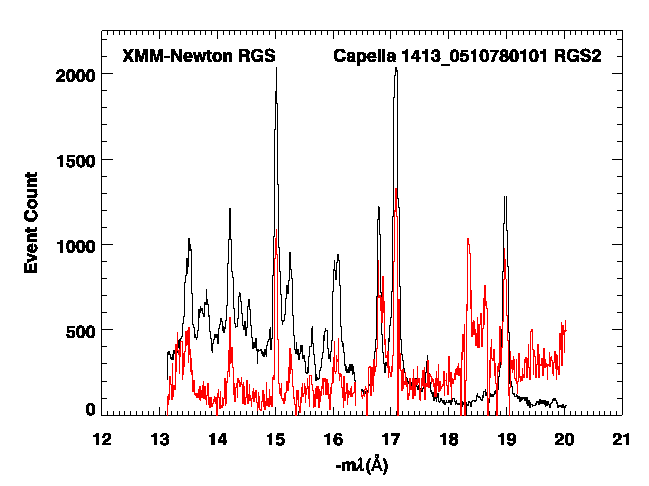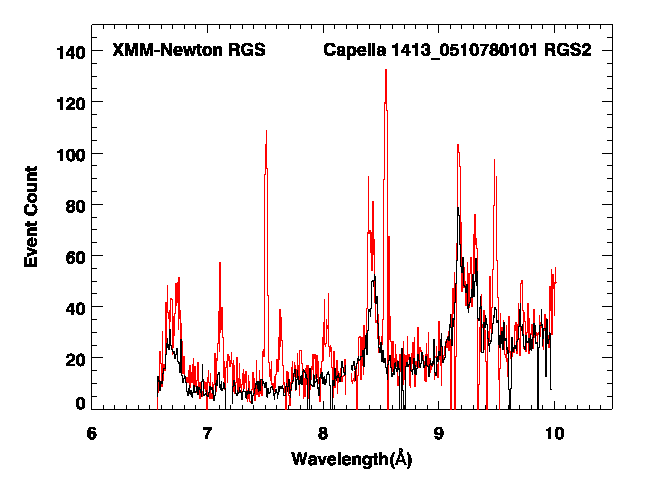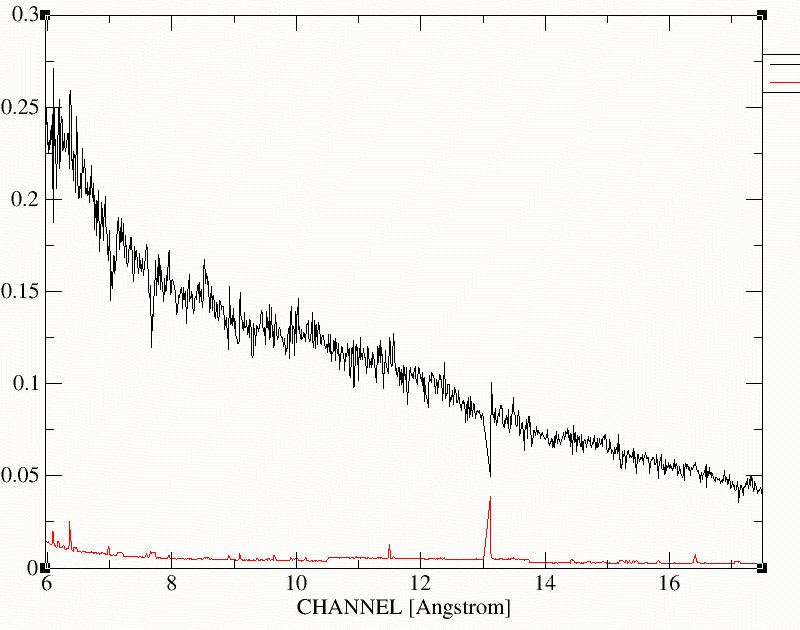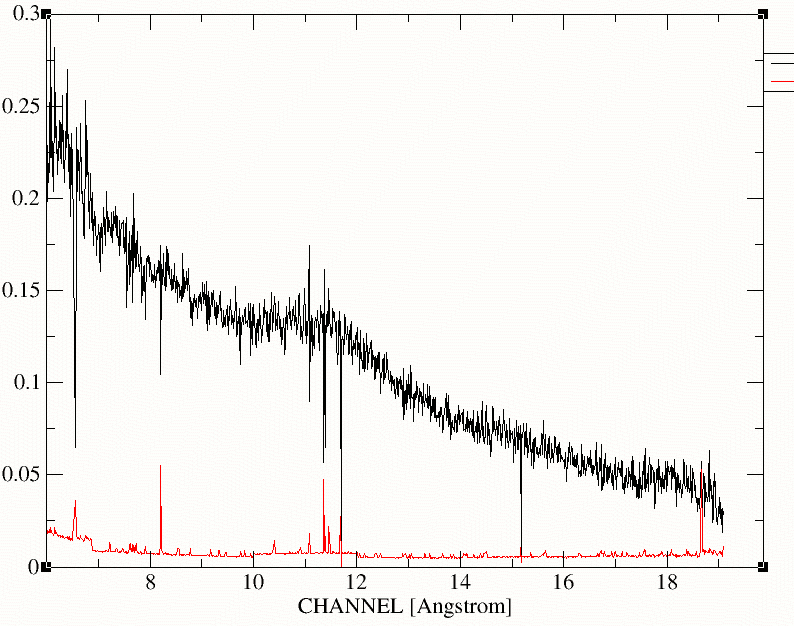SAS Thread - pile up in the rgs - XMM-Newton
Pile-up in RGS: how to evaluate and prevent it
|
Introduction This thread illustrates:
Expected Outcome Plot comparing the first and second order spectra for each RGS for a given source. If first and second order spectra agree, pile-up is not a problem for this source. SAS Tasks to be Used Prerequisites Useful Links Last Reviewed: 31 January 2025, for SAS v22.0Last Updated: 16 January 2017 |
Procedure
Pile-up occurs whenever more than one photon hits a single pixel during one integration time. Pile-up will cause two coincident first-order photons to combine into a single second-order event at the same spatial position on the detector but apparently with half the wavelength. In addition, at locations on the CCD where multiple-pixel events are more likely, pile-up will have a higher chance to result in the type of complicated event patterns that get discarded by the on-board processing and thus removed from the data. Thus, pile-up may differ between RGS1 and RGS2 and may vary between CCD locations due to the event pattern distribution variations over the detectors.
The effects of pile-up on spectra are therefore two-fold:
- Migration of photons from first to second order (or from second order to third order).
- Rejection of events with 'complicated patterns' by the on-board processing.
In piled-up observations, any spectral features which are identified can only be trusted if they are consistent between the different RGS and orders. One should consider potential pile-up if the total source flux per CCD approaches the following levels:
| 2% pile-up flux | 2% pile-up flux | ||||
| (erg cm-2 s-1) | (erg cm-2 s-1) | ||||
| RGS1 | CCD1 | 7.1E-10 | RGS2 | CCD1 | 3.1E-10 |
| RGS1 | CCD2 | 5.0E-10 | RGS2 | CCD2 | 2.1E-10 |
| RGS1 | CCD3 | 3.8E-10 | RGS2 | CCD3 | 1.6E-10 |
| RGS1 | CCD4 | 3.3E-10 | RGS2 | CCD4 | - |
| RGS1 | CCD5 | 2.9E-10 | RGS2 | CCD5 | 1.5E-10 |
| RGS1 | CCD6 | 3.2E-10 | RGS2 | CCD6 | 1.4E-10 |
| RGS1 | CCD7 | - | RGS2 | CCD7 | 1.9E-10 |
| RGS1 | CCD8 | 7.1E-10 | RGS2 | CCD8 | 3.7E-10 |
| RGS1 | CCD9 | 20.0E-10 | RGS2 | CCD9 | 14.1E-10 |
| Double-node readout | Single-node readout | ||||
|---|---|---|---|---|---|
In rough terms, any individual CCD with a total count rate in all orders of more than 12 cts/s in RGS1 and 6 cts/s in RGS2 may suffer from pile-up. Starting in August 2007, RGS2 CCDs are read via a single node. RGS2 frame times are therefore twice as long as RGS1 time frames. This is why the RGS2 limit is half the RGS1 limit.
In case that the count rates above are present in an observation, potential effects should be considered and suitable diagnostics executed, such as inspection of ratio of first and second order fluxed spectra. The RGS calibration of the effective area ensures that the fluxed spectra of first and second spectral orders of non-piled-up sources agree within a few percent. Therefore, sources for which the fluxed spectra of, say, first and second order differ by more than 10% are likely to be suffering from pile-up.
The strong emission lines in Capella give the opportunity to make a reliable quantitative assessment of the pile-up fraction.
The next figures show the effects of pile-up in a RGS2 single-node observation of Capella:
How to compare first and second order spectra
- Obtain calibrated spectra and response matrices for the first and second order spectra of RGS1 and RGS2 (see thread: How to reduce RGS data and extract spectra of point-like sources). If you followed the previous thread to the end, you will already have as a product fluxed spectra with names PxxxxxxyyyyOBX000fluxed1000.FIT and PxxxxxxyyyyOBX000fluxed2000.FIT (following the naming convention of the above specified thread) and you can skip the next point.
- Run rgsfluxer to obtain fluxed spectra in first and second order:
rgsfluxer pha='PxxxxxxyyyyR1zeeeSRSPEC1001.FIT PxxxxxxyyyyR2zeeeSRSPEC1001.FIT' rmf='PxxxxxxyyyyR1zeeeRSPMAT1000.FIT\
PxxxxxxyyyyR2zeeeRSPMAT1000.FIT' file=flux_1storder.fits
rgsfluxer pha='PxxxxxxyyyyR1zeeeSRSPEC2001.FIT PxxxxxxyyyyR2zeeeSRSPEC2001.FIT' rmf='PxxxxxxyyyyR1zeeeRSPMAT2000.FIT\
PxxxxxxyyyyR2zeeeRSPMAT2000.FIT' file=flux_2ndorder.fits
- Plot the fluxed spectra in first and second order:
dsplot table=flux_1storder.fits (or dsplot table=PxxxxxxyyyyOBX000fluxed1000.FIT)
dsplot table=flux_2ndorder.fits (or dsplot table=PxxxxxxyyyyOBX000fluxed2000.FIT) - Compare the fluxed spectra:
How to prevent pile-up
The easiest remedy against pile-up is faster readout of the CCDs. If only one CCD is read instead of 8, the integration time per frame of 4.8s is reduced by a factor 8, thus reducing pile-up by the same amount. One can consider to have different readout modes for the two RGS. Having one RGS in single CCD mode and the other in double CCD readout mode, the frame times of both RGS differ by a factor of two, but are still both faster than in 8-CCD readout. This difference will allow to make an estimate of pile-up. When there is minimal difference between the two RGS observed, pile-up is not important. Other modes, e.g. going from 4 to 2 to 1 CCD readout mode can be considered depending on the flux expected per CCD.
How to deal with piled-up spectra
Repair of piled-up spectra is limited and can currently only be done with ad hoc methods in some special cases, e.g., when the source spectrum is very soft and it can be safely assumed that the visible second order spectrum is due only to piled-up first order photons.
- Removed a total of (3) style text-align:center;
- Removed a total of (7) style text-align:justify;
- Removed a total of (18) align=center.
- Removed a total of (5) border attribute.
- Removed a total of (3) cellpadding attribute.
- Removed a total of (3) cellspacing attribute.
- Converted a total of (5) center to div.








































 Sign in
Sign in
 Science & Technology
Science & Technology



